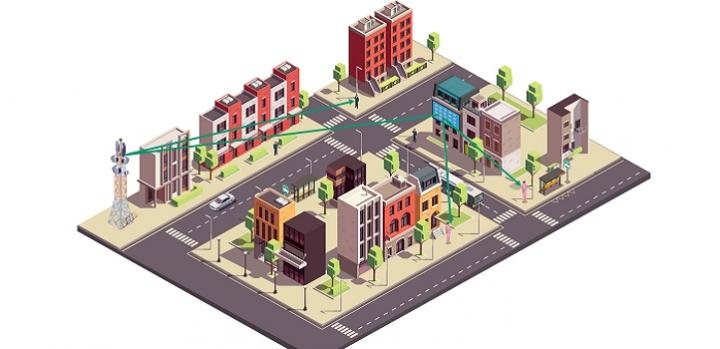Intelligent surfaces signal better coverage

Reconfigurable intelligent surfaces (RISs) on buildings could significantly improve communication network coverage. The RIS system could eliinate blind spots by redirecting signals that would otherwise be blocked by buildings.
Credit: © 2020 KAUST Mustafa Kishk & Maha M. Kamal
Specialized reflective panels located on top of buildings and deployed widely across a city could significantly improve network coverage, shows a KAUST modeling study.
Next-generation cellular networks (5G and beyond) will provide communication coverage to wider rural areas, while improving data exchange rates to meet rapidly rising demand. In urban areas in particular, obstacles in the form of buildings and other structures can impede wireless communication links, reducing mobile device signals and slowing data exchange.
Research has shown that reconfigurable intelligent surfaces (RISs) hold great promise as a technology for eliminating communication “blind spots” caused by blockages. RISs are specially designed surfaces comprising multiple reflective elements that can modify and redirect incoming signals, allowing for better control and performance over an entire communication network. RISs can be opaque or transparent, and they are well established in terms of their energy efficiency and effectiveness at manipulating signals. An RIS system can use both localization and beam tracking technologies to pinpoint a user’s location and to follow their device–even if they are moving in a car at high speed.
“The RIS system and the way it reflects signals has been thoroughly studied in the literature, leading to various useful mathematical models,” explains postdoc Mustafa Kishk, who conducted the study with his advisor Mohamed-Slim Alouini. “We used one of these well-established models for RIS behavior in our system setup. Then, using a mathematical tool called stochastic geometry, we created a large-scale system that distributes RISs at random on the faces of buildings. We then analyzed the probable coverage gains under different scenarios.”
The results demonstrate that RISs can dramatically improve coverage in areas with blind spots. At a density of 300 blockages per square kilometer, the researchers found that only six RISs would be needed per kilometer to significantly enhance coverage. However, if the blockage density rises to 700 per kilometer, the system becomes inherently far more complex, and an estimated 490 RISs per kilometer would be needed.
“An interesting question still to be answered is whether there is an optimum number of RISs that can be deployed in any one area before they begin to interfere with one another,” says Kishk.
“Our model can be used to anticipate the performance of any given large-scale network,” adds Alouini. “We believe it will provide accurate, rapid assessments of potential real-world RIS applications. We could see RISs deployed in 6G networks, possibly in a decade.”
All latest news from the category: Information Technology
Here you can find a summary of innovations in the fields of information and data processing and up-to-date developments on IT equipment and hardware.
This area covers topics such as IT services, IT architectures, IT management and telecommunications.
Newest articles

New insights into sleep
…uncover key mechanisms related to cognitive function. Discovery suggests broad implications for giving brain a boost. While it’s well known that sleep enhances cognitive performance, the underlying neural mechanisms, particularly…

3D-printing advance
… mitigates three defects simultaneously for failure-free metal parts. University of Wisconsin–Madison engineers have found a way to simultaneously mitigate three types of defects in parts produced using a prominent…

Ancient hot water on Mars points to habitable past
Curtin study. New Curtin University-led research has uncovered what may be the oldest direct evidence of ancient hot water activity on Mars, revealing the planet may have been habitable at…



